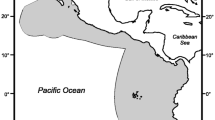Abstract
This paper presents and discusses the levels and temporal trends of concentrations of Cd, Pb, Hg, Cu, Zn, and As in livers and Hg in the muscle tissues of cod (Gadus morhua L) from the Baltic Sea during the period 1994–2010. Concentrations of Pb, Hg, and Cd exhibited significant downward trends. Cu and Zn concentrations exhibited upward trends in the period 1994 to 2010. No trends were detected for concentrations of As. The temporal trends identified in heavy metal concentrations in cod livers corresponded to the directions of changes in concentrations of these elements introduced into the Baltic Sea via river runoff and atmospheric emission, and those in surface and deep waters of the Baltic. Downward trends in the concentrations of toxic metals in cod livers suggest that advantageous changes are occurring in concentrations of heavy metals in the environment of the southern Baltic Sea.


Similar content being viewed by others
References
Bignert, A., Nyberg, E., & Danielsson, S. (2007a). Cadmium concentrations in fish liver. HELCOM Indicator Fact Sheets 2007. Accessed 22 July 2011. http://www.helcom.fi/BSAP_assessment/ifs/archive/ifs2007/en_GB/cadmium_fish/.
Bignert, A., Nyberg, E., & Danielsson, S. (2007b). Lead concentrations in fish liver. HELCOM Indicator Fact Sheets 2007. Accessed 22 July 2011.
Bignert, A., Nyberg, E., & Danielsson, S. (2007c). Mercury concentrations in fish muscle. HELCOM Indicator Fact Sheets 2007. Accessed 22 July 2011.
Bignert, A., Nyberg, E., Asplund, L., & Wilander, A. (2008). Comments concerning the National Swedish Contaminant Monitoring Programme in Marine Biota, 2008. Report to the Swedish Environmental Protection Agency. HELCOM Indicator Fact Sheets 2007. Accessed 10 July 2011. http://www.nrm.se/download/18.61d98c3a11a91af311a80001279/Marina+programmet+2008.
Bignert, A., Boalt, E., Danielsson, S., Hedman, J., Johansson, A.-K., Miller A., Nyberg E., Berger, U., Borg, H., Eriksson, U., Holm, K., Nylund, K., & Haglund, P. (2011). Comments concerning the National Swedish Contaminant Monitoring Programme in Marine Biota, 2011. Sakrapport till Naturvårdsverket nr 7:2011, 224 pp. (MG 1082). http://www.nrm.se/en/menu/researchandcollections/departments/contaminantresearch/publications.955_en.html. Accessed 10 January 2012.
Cossa, D., Auger, D., Averty, B., Lucon, M., Masselin, P., & Noel, J. (1992). Flounder (Platichthys flesus) muscle as an indicator of metal and organochlorine contamination of French Atlantic coastal waters. Ambio, 21, 176–182.
Fryer, R. J., & Nicholson, M. D. (2002). Assessing covariate-dependent contaminant time-series in the marine environment. ICES Journal of Marine Sciences, 59, 1–14.
Gusev, A. (2009). Atmospheric deposition of heavy metals on the Baltic Sea. HELCOM Indicator Fact Sheets 2009. Accessed 22 June 2010. http://www.helcom.fi/BSAP_assessment/ifs/ifs2009/en_GB/hmdeposition/.
HELCOM (2010). Hazardous substances in the Baltic Sea—an integrated thematic assessment of hazardous substances in the Baltic Sea. Baltic Sea Environment Proceedings, No. 120B. Accessed 22 June 2010. http://www.helcom.fi/publications/en_GB/publications/.
HELCOM PLC-Group (2009). Waterborne inputs of heavy metals to the Baltic Sea. HELCOM Indicator Fact Sheets 2008. Accessed 22 June 2010. http://www.helcom.fi/BSAP_assessment/ifs/ifs2009/en_GB/waterborne_hm/.
ICES (2007). Temporal trends in contaminants in herring in the Baltic Sea in period 1980–2005. HELCOM Indicator Fact Sheets 2007. Accessed 10 July 2011. http://www.helcom.fi/BSAP_assessment/ifs/archive/ifs2007/en_GB/contaminants/.
Julshamm, K., & Grahl-Nielson, O. (1996). Distribution of trace elements from industrial discharges in the Hardangerfjord, Norway: a multivariate data analysis of saithe, flounder and blue mussel. Marine Pollution Bulletin, 32, 564–571.
Kremling, K., & Streu, P. (2000). Further evidence for a drastic decline of potentially hazardous trace metals in Baltic Sea surface waters. Marine Pollution Bulletin, 40(8), 674–679.
Leah, R. T., Evans, J. J., & Johnson, M. S. (1992). Mercury in flounder (Platichthys flesus) from estuaries and coastal waters of the northeast Irish Sea. Environmental Pollution, 75, 317–322.
Lind, Y., Bignert, A., & Odsjo, T. (2006). Decreasing lead levels in Swedish biota revealed by 36 years (1969–2004) of environmental monitoring. Journal of Environmental Monitoring, 8, 824–834.
Niemirycz, E., & Bierawska, B. (1998). Environmental conditions of the Polish Baltic coastal zone in 1997. Inflow of pollution to the sea. Materiały Oddziału Morskiego IMGW, Gdynia, 12–14 (In Polish).
Niemirycz, E., Kaczmarek, A., & Makowski, Z. (2004). Environmental conditions of the Polish Baltic coastal zone in 2001. Inflow of pollution to the sea. Materiały Oddziału Morskiego IMGW, Gdynia, 12–14 (In Polish).
PN-EN 14546 (2005). Foodstuffs—determination of trace elements—determination of total arsenic by hydride generation atomic absorption spectrometry (HGAAS) after dry ashing. Polish Norms, PKN, Warszawa (In Polish).
Pohl C., & Hennings, U. (2009). Trace metal concentrations and trends in Baltic surface and deep waters. HELCOM Indicator Fact Sheets 2009. Accessed 20 May 2010. http://www.helcom.fi/BSAP_assessment/ifs/ifs2009/en_GB/HeavyMetalsWater/
Polak-Juszczak, L. (2009). Temporal trends in the bioaccumulation of trace metals in herring, sprat, and cod from the southern Baltic Sea in the 1994–2003 period. Chemosphere, 76, 1334–1339.
Trzosińska, A., & Andrulewicz, E. (1998). Short-term effects of 1997 flood on the marine environment of the Gulf of Gdańsk and Pomeranian Bay. Studies and Material, Sea Fisheries Institute in Gdynia, 66–72.
Voight, H.-R. (1999). Concentrations of heavy metals in fish from coastal waters around the Baltic Sea. ICES Journal of Marine Science, 56(suppl), 140–141.
Voight, H.-R. (2002). Umweltwissenschaften und Schandstoff. Forschung, 15, 234–239.
Working Group 4 (1999). Flood of 1997. Oder River basin. In: The International Commission to Protect the Oder River from Pollution, Wrocław, 100–103. (In Polish). Accessed 20, May 2010 http://www.mkoo.pl//index.php?mid=4&aid=72 (Powodz 1997.pdf).
Author information
Authors and Affiliations
Corresponding author
Additional information
Highlights
–Trace elements in the livers of cod in the 1994–2010 period: concentrations and trends.
–Downward temporal trends in concentrations of Cd, Pb, and Hg.
–Lack of trends in concentrations of As, Cu, or Zn.
–Cod livers can be used as indicators of cadmium and lead pollution in the Baltic Sea.
–Muscle tissues can be useful tool to track mercury pollution in environment.
Rights and permissions
About this article
Cite this article
Polak-Juszczak, L. Trace elements in the livers of cod (Gadus morhua L.) from the Baltic Sea: levels and temporal trends. Environ Monit Assess 185, 687–694 (2013). https://doi.org/10.1007/s10661-012-2584-2
Received:
Accepted:
Published:
Issue Date:
DOI: https://doi.org/10.1007/s10661-012-2584-2




